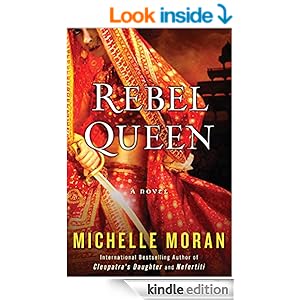About the book (description from Goodreads:)
When the British Empire sets its sights
on India in the 1850s, it expects a quick and easy conquest. After all, India
is not even a country, but a collection of kingdoms on the subcontinent. But
when the British arrive in the Kingdom of Jhansi, expecting its queen to
forfeit her crown, they are met with a surprise. Instead of surrendering, Queen
Lakshmi raises two armies—one male, one female—and rides into battle like Joan
of Arc. Although her soldiers are little match against superior British
weaponry and training, Lakshmi fights against an empire determined to take away
the land she loves.
Told from the perspective of Sita, one of the guards in Lakshmi's all-female army and the queen’s most trusted warrior, The Last Queen of India traces the astonishing tale of a fearless ruler making her way in a world dominated by men. In the tradition of her bestselling novel Nefertiti, which Diana Gabaldon, author of the Outlander series, called “a heroic story with a very human heart,” Michelle Moran once again brings a time and place rarely explored in historical fiction to rich, vibrant life.
Told from the perspective of Sita, one of the guards in Lakshmi's all-female army and the queen’s most trusted warrior, The Last Queen of India traces the astonishing tale of a fearless ruler making her way in a world dominated by men. In the tradition of her bestselling novel Nefertiti, which Diana Gabaldon, author of the Outlander series, called “a heroic story with a very human heart,” Michelle Moran once again brings a time and place rarely explored in historical fiction to rich, vibrant life.
My review:
Rebel Queen was a fascinating and
gripping tale about a different culture and a time in history that -- like many
Americans -- I know little about. I haven't read many stories that included
Queen Victoria, so that interested me. I have read a few books regarding the
East Indian culture and their relationship with England during the early 1900s,
all told from the Indian perspective. The contrast between the British culture
and Indian culture during that time period is fascinating. I loved how the
Indian men were appalled by the exposure of women's breasts, shoulders and
necks from English fashion and the English couldn't understand the exposure of
the waistline that was part of Indian fashion. Then again, you can't very
easily use a corset on a bare waistline. How fortunate for the women of India.
The British Empire's insatiable thirst for more land
showed in the narrative, but was skillfully woven and subtle in the approach.
The point of view was flawless. All Sita knew about England came from reading
English novels and authors like Shakespeare. The author was fair with the
details and showed the horrors of what both people groups did to each other.
The Indian rebels caused a lot of problems for the kingdom because of their
aggression, but they were simply trying to oust the imperialistic people who
decided India should be theirs, much like the Native Americans tried to defend
their land using similar horrific means. Annexing another country to their
empire often require nothing more than their presence. Intimidation by their
occupancy and weaponry was effective indeed. I felt kind of bad for the people
who didn't want to be there but were forced to occupy the land because they
were enlisted and it was their assignment.
I found it sad how the Rani (Queen) and Sita both
trusted England to respond positively to their appeal hoping that because they
were women and also had a female regent, it would matter. They didn't fully
understand the limitations caused by Parliament and the empire's greed. The
treachery within the ranks of the Durgavasi was appalling as well. But you have
to read the story to figure out what I mean by that. Anyway, I read this book
fairly fast considering I don't have much reading time these days. The story
was filled with culture and history and the author swept me out of this present
day and into the past through her use of scenery, foods, clothing and decor. I
love it when I can go to another place in my mind and feel grounded in that
fantasy world. This isn't always the case with fiction, so the author did an
exceptional job there.
I loved how the author told the story from Sita's
perspective. That made the novel even more powerful because you got to see the
Hindu influence as well as the Muslim influence of the culture during that time
period. Women were not valued and seen as a liability due to the enormous dowry
that was required for a marriage. The fact that young ladies were married off
around ten was pretty disturbing too. At least the husbands traditionally waited
for the young girl to turn into a young woman before consummating the marriage.
Anyway, I found this book to be compelling and well told. I would definitely
recommend it to anyone who enjoys a story that effectively takes you to another
time and place in your mind.

No comments:
Post a Comment